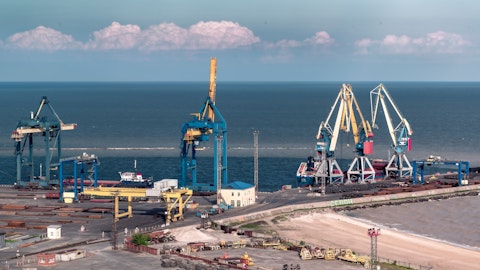Jeoffrey Lambujon: First, one is on the ops and capital allocation side. If you can just speak to any more detail on next year’s plan in terms of where you might focus within the Midland Basin, both in terms of geography, but also maybe just less active zones in terms of industry activity that you may be testing more, and if you could speak maybe a bit more onto some of that laterally in the commentary in terms of how that might evolve over the near-term program? That would be helpful as well.
Daniel N. Wesson: Yes. Jeff, with these longer cycle projects we have a pretty good view of what the projects look like coming up here in 2024. I’d say generally we’re going to be in the range of 11,000 feet average lateral length, probably maybe even a little bit more than that. I would say it’s also a very heavy, Martin County development year for us, which is great, large scale, multi-zone development, and some of the best undeveloped resource remaining in the Midland Basin. I’d say, from a testing perspective some more wells can be probably making it into the plan and a lot more Upper Spraberry making it into the plan. We kind of have a couple really good tests and part of our culture is when something works, we implement it very, very quickly. And that’s how we kind of see the shallower development picking up the pace in the Northern Midland Basin, particularly that Northwest Martin County area that we feel really good about for adding a new zone.
Jeoffrey Lambujon: Okay, great. And then maybe just a housekeeping type question on the non-core asset sales side, particularly on the upstream. I think a few people noted now just how you’re exceeding or you’ve already exceeded the target, before year end here, and it makes sense that there’s no need to go out, and do more right away. But just wondering if you could speak to potential opportunities, maybe in terms of longer dated inventory that someone else might find more valuable than theirs, how do you think about opportunities that can near?
Kaes Van’t Hof: Yes. A good question. That ties to something that Danny answered your last question. The number of wells in the Midland Basin will be kind of 85%, 90% of total capital. So, the Delaware Basin still be a small percentage of total capital. I think if I’m getting what your question is, it’s what, where does the Delaware Basin sit in the portfolio. I think, for us certainly we start that area of capital a little bit here in the last few years. I think it provides a lot of cash flow and a lot of production which is beneficial to us today. But, as you’ve seen over the course of the year, it certainly seems like, inventory is coming in a premium. And, there may come a time where someone really, really wants to Delaware position of ours or portions of it but we’re not going to sell it for [ASONG] (ph) and PD15, right, PDP.
So, I think we’re going to hold it for now. And if someone wants to pay for upside in a reasonable, number versus where we trade, we’ll take a look at it.
Jeoffrey Lambujon: Perfect. Thank you.
Travis D. Stice: Thanks, Jeff.
Operator: Thank you. One moment for our next question. Our next question comes from the line of Nitin Kumar of Mizuho. Your line is now open.
Nitin Kumar: Hi, good morning, guys, and thanks for taking my question. Travis, I want to start on slide 11. That you’ve been espousing the co-development approach for some time and you show pretty solid results, and consistent results since 2020. Just curious, one of your, I guess, peers in the Basin talked about increasing recoveries by 20%, through the use of technology. You guys are at the cutting edge yourself, so I’m curious are you seeing anything out there that can improve recovery factors by that kind of magnitude?
Travis D. Stice: Nitin, we keep our figure on the pulse of a lot of emerging technologies. We focus our internal expertise on improving recovery. That’s not something that’s on our radar screen that we’re aware of today, but that’s not to say that the potential is not there as you look forward in the future. There’s a lot of smart guys in our industry. We have a ton of smart guys inside Diamondback, and whether that technology is developed internally or externally, it’s widely communicated and quickly followed as particular that kind of result. So, we’re focused on improving recovery and I know our peers are doing the same. That’s not a today number for sure, though.
Nitin Kumar: I guess my follow-up would be if you are a fast follower you’ve talked about how volume is an output of your program, your capital allocation framework, in an event that you could improve recoveries that way, would you allow, would you keep activity flat, or do you expect to reduce CapEx and just maintain that volume growth to be in the low-single-digits?
Daniel N. Wesson: Yes. I mean, I think generally that would be a great problem to have. It really ties to this can you run a SimulFRAC program consistently on that position and those projects and those paths kind of goes all those back to this longer cycle nature of the shale business model. And, I think, we feel really good about four SimulFRAC crews running consistently right now, Nitin, and have the infrastructure to do that. And, if growth exceeded expectations there’ll be a good problem to have.
Nitin Kumar: Great. Thanks. That’s it for me guys.
Operator: Alright. Thank you. One moment for our next question. Next question comes from the line of Charles Meade of Johnson Rice. Your line is now open.
Charles Meade: Good morning. Travis, Kaes and Danny. I want to ask one more question, but maybe from a different angle on the on the A&D outlook. Kaes, I think it was, I think I wrote down what you said that, in your prepared comments or maybe earlier Q&A, that there’s very few positions out there that you envy. And so, that makes sense that you guys, your bar is high. But from my seat, it also looks like if you look at the other side of the equation, it looks like, there not a lot of positions you want to buy, but there’s also fewer possible, fewer potential buyers out there, particularly for some of these large, large private positions. So, how does the — I guess do you agree that there’s fewer credible buyers some of these big packages that may still be out there. And more broadly, how’s the kind of the lineup shifting is your active in data rooms and in processes buyers versus sellers?




